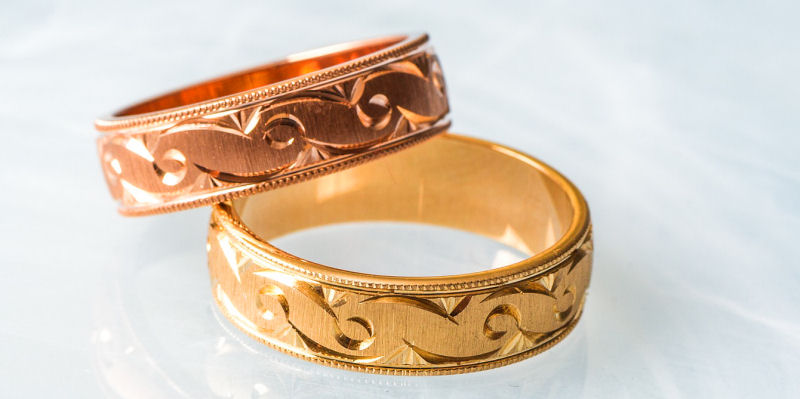While pure gold is yellow in color, gold can also appear to have other colors. These colors are generally obtained by alloying gold with other elements in various proportions.
For example, alloys which are mixed 14 parts gold to 10 parts alloy create 14-karat gold, 18 parts gold to 6 parts alloy creates 18 karat, and so on. This is often expressed as the result of the ratio, ie: 14/24 equals 0.585 (rounded off), and 18/24 is 0.750. There are hundreds of possible alloys and mixtures, but in general the addition of silver will color gold green, and the addition of copper will color it red. A mix of around 50/50 copper and silver gives the range of yellow gold alloys the public is accustomed to seeing in the marketplace.
Contents:
White gold
White gold is an alloy of gold and at least one white metal, usually nickel or palladium. Like yellow gold, the purity of white gold is given in karats.
White gold’s properties vary depending on the metals and proportions used. As a result, white gold alloys can be used for different purposes; while a nickel alloy is hard and strong, and therefore good for rings and pins, gold-palladium alloys are soft, pliable and good for white gold gemstone settings, sometimes with other metals like copper, silver, and platinum for weight and durability, although this often requires specialized goldsmiths. The term white gold is used very loosely in the industry to describe karat gold alloys with a whitish hue. Many believe that the color of the rhodium plating, which is what they see on many commercial pieces, is actually the color of white gold. The term white covers a large spectrum of colors that borders or overlaps pale yellow, tinted brown, and even very pale rose. The jewellery industry often hide these off-white colours by rhodium plating.
About one person in eight has a mild allergic reaction to the nickel in some white gold alloys when worn over long periods of time. A typical reaction is a minor skin rash. White gold alloys made without nickel are less likely to be allergenic.
Rose, red, and pink gold
Rose gold is a gold and copper alloy widely used for specialized jewelry due to its reddish color. It is also known as pink gold and red gold. As it was popular in Russia at the beginning of the nineteenth century, it is also known as Russian gold, although this term has become somewhat rare.
Although the names are often used interchangeably, the difference between red, rose, and pink gold is the copper content-the higher the copper content, the stronger the red coloration, as pure gold is yellow and pure copper is reddish. A common alloy for rose gold is 75% gold and 25% copper by mass (18 karat). Since rose gold is an alloy, there is therefore no such thing as “pure rose gold”.
The highest karat version of rose gold is also known as crown gold, which is 22 karat. 18 karat red gold may be made of 25% copper and 75% gold. For 18 karat rose gold, typically about 4% silver is added to the 75% gold and 21% copper to give a rose color. 14 karat red gold is often found in the Middle East and contains 41.67% copper.
Green gold
Green gold alloys are made by leaving the copper out of the alloy mixture, and just using gold and silver. It actually appears as a greenish yellow, rather than as green. Eighteen karat green gold would therefore contain a mix of gold 75% and silver 25%. Fired enamels adhere better to these alloys.
Grey gold
Grey gold alloys are made by adding silver, manganese and copper in specific ratios to the gold.
Black gold
Black gold is a type of gold used in jewellery. Black colored gold can be produced by various methods:
- Electroplating, using black rhodium or ruthenium. Solutions that contain ruthenium give a slightly harder black coating than those that contain rhodium.
- Patination by applying sulfur and oxygen containing compounds.
- Plasma assisted chemical vapor deposition process involving amorphous carbon, and controlled oxidation of karat gold containing chromium or cobalt.
More recently a laser technique has been developed that renders the surface of metals deep black. A femtosecond laser pulse deforms the surface of the metal forming nanostructures. The immensely increased surface area can absorb virtually all the light that falls on it and thus rendering it deep black.
Purple and blue golds
Purple gold (also called amethyst or violet gold) is an alloy of gold and aluminium. Gold content is around 79% and can therefore be referred to as 18 karat gold. Purple gold is more brittle than other gold alloys, and a sharp blow may cause it to shatter. It is therefore usually machined and faceted to be used as a ‘gem’ in conventional jewelry rather than by itself. Blue gold is similarly an alloy, a mixture of gold and indium or gallium.






